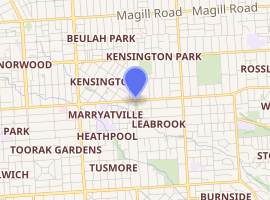The Regal Theatre, Kensington Park
The Regal Theatre, formerly known as the Chelsea Cinema, and before that, the Princess Theatre and then the Marryatville Ozone Theatre, is a single-screen cinema in Kensington Park, a suburb of Adelaide, South Australia. It was built in the Art Deco style in 1925 and is heritage-listed.
| The Regal Theatre | |
|---|---|

| |
| Former names |
|
| General information | |
| Architectural style | Art Deco |
| Town or city | Kensington Park (Adelaide), South Australia |
| Country | Australia |
| Completed | 1925 |
| Design and construction | |
| Architect | C A Smith |
History
The cinema's location at no. 275 Kensington Road forms part of a ribbon development of businesses along the arterial road, usually referred to as the Marryatville shops, although the businesses span four suburbs. The Marryatville Hotel is in Kensington, and the cinema was built in proximity to the post office and former primary school, police station and bowling club sites. Coopers Brewery was nearby in Leabrook, and many of its employees lived in the area at the time.
The cinema was opened on 24 November 1925 by National Cinemas as the Princess Theatre. At the time of opening, the seating capacity was 1300 persons. (The current capacity is some 580 people.) The cinema was sold in 1928 to Ozone Theatres and renamed the Marryatville Ozone Theatre.
An Adelaide News advertisement on 30 May 1941 states the cinema had two sessions: an evening one at 7:50pm on weeknights and a matinée session at 2:00pm on Wednesdays and Sundays. Reservations could be made by telephoning the cinema. The initial refurbishment in 1941 included new facilities and internal structures. A function room, parents' room and facilities for the hearing-impaired were also installed. The entrance foyer included a fireplace, and upholstered seating was provided. The plaster mouldings adorning the roof and walls of the cinema were added at this time.
The cinema was sold to the Hoyts Group in 1951. A cinemascope screen replaced the smaller traditional screen removed in 1955, allowing for a wider range of films to be shown. The Burnside City Council bought the building in 1964 and it was leased back to the Hoyts company.
In 1971, Wallis Cinemas took over the lease, as part of their expansion across Adelaide, saving the cinema from demolition. The cinema's future was discussed at a council meeting in 1977, due to the ongoing need for restoration of the cinema. Wallis replaced the screen and reduced the seating capacity, with some of the sections of the building found to be infested with white ants.
Another major renovation took place in 1983–1984. The screen and projection equipment were again updated by Wallis, allowing the cinema to compete with the then fledgling video industry. The "crying room" (a soundproofed room for parents with babies) was developed into a galley for the confectionery bar area. Subsequently, the function room was usurped as the crying room. It was one of the last cinemas in Adelaide to still have foot warmers (via a hot water pipe system) during the 1980s.
Wallis ceased operations at the end of their lease of the cinema in 2009. Republic Theatres took over the running of the cinema in 2012.[1]
Heritage listing
Since 1983, the cinema has been listed on the State Heritage Register.
Features of the Cinema
- Red brick external walls as part of the rear of the cinema complex
- A Dolby Digital Surround Sound system
- A soundproofed Crying Room for parents
- Airconditioning and heating
- Art deco bathroom facilities
- Shops located on either side of the cinema entrance
Configuration and capacity
The cinema is a single screen complex with space for 580 patrons. The original configuration allowed for an orchestra pit around the screen area.
There is a 'vacant' garden block to the east of the cinema owned by the council. This site also contains public toilets and a cinema carpark accessible via Uxbridge Street and May Terrace. This site is a contentious one, allowing the possibility for the cinema to be extended to a twin or multi screen theatre. The closure of the Glenelg Wallis Cinema (also a multi-screen cinema) makes this prospect less likely. With smaller sized cinemas in proximity (Norwood and Magill) the competition is strong for patronage. The site is also used for charity fundraising events on a regular basis.
Modern cinematic presentation features
The cinema has many modern features including an upgraded screen and Dolby Digital sound system.
The cinema is also capable of projecting 70mm films.
Authentic Art Deco restoration
While the cinema has modern presentation features, its appearance has been carefully restored to its 1941 Art Deco design, including:
- Exterior and interior decoration restored to original 1941 colours and styles
- Georgian motifs within the design work of the cinema and the associated powder room and bathroom
- Carved emblems in the foyer area as well as a wooden and chrome ticket box
- Original 1941 design carpeting
- Replica 1941 Art Deco fireplace, mirror & wooden Venetians in the upstairs foyer
- Lounge seats and column decorations within the main foyer area
Operation and programming
The cinema operates mainstream cinema programming. It has an affluent clientele base and also shows a range of Arthouse films.
Historically, the cinema is well known for its Rocky Horror Picture Show screenings (two sessions - late and midnight) during the 1980s.
See also
- Wallis Cinemas South Australian cinema circuit
- Movie theatre